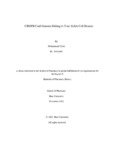| dc.contributor.advisor | Islam, Farzana | |
| dc.contributor.author | Ullah, Mohammad | |
| dc.date.accessioned | 2023-08-08T05:38:57Z | |
| dc.date.available | 2023-08-08T05:38:57Z | |
| dc.date.copyright | 2022 | |
| dc.date.issued | 2022-11 | |
| dc.identifier.other | ID 18346005 | |
| dc.identifier.uri | http://hdl.handle.net/10361/19355 | |
| dc.description | This thesis is submitted in partial fulfillment of the requirements for the degree of Bachelor of Pharmacy, 2022. | en_US |
| dc.description | Cataloged from PDF version of thesis. | |
| dc.description | Includes bibliographical references (pages 49-54). | |
| dc.description.abstract | The most prevalent inherited blood condition, Sickle Cell Disease (SCD) causes excruciating
pain, permanent organ damage including liver, heart, and kidney also causes an untimely
death. There is currently a dearth of treatment options for SCD. In order to lessen the severity
of acute problems, only four medications have been licensed by the Food and Drug
Administration (FDA). Hematopoietic stem cell transplantation, is the curative treatment for
SCD, that is related to matched donor. Recent and significant advancements in genome
editing techniques have shown promise as a curative option, with the potential to fix the
mutation in patient-derived Hematopoietic Stem/Progenitor Cells (HSPCs), to increase Fetal
Hemoglobin (HbF) expression to avoid sickling of Red Blood Cells (RBCs), and generate
corrected induced Pluripotent Stem Cells (iPSCs). CRISPR/Cas9, which was discovered
relatively recently, has not only changed the face of genome engineering, but also made it
possible to use these ideas in the clinic. In this review, we provide an overview of
CRISPR/Cas9 applications in genome engineering and discuss the advantages, disadvantages,
how it is superior to other gene editing technologies such as Zinc Finger Nucleases (ZFNs)
and Transcription Activator-Like Effector Nucleases (TALENs) and potential of this
technology as a treatment for SCD. | en_US |
| dc.description.statementofresponsibility | Mohammad Ullah | |
| dc.format.extent | 54 pages | |
| dc.language.iso | en | en_US |
| dc.publisher | Brac University | en_US |
| dc.rights | Brac University theses are protected by copyright. They may be viewed from this source for any purpose, but reproduction or distribution in any format is prohibited without written permission. | |
| dc.subject | SCD | en_US |
| dc.subject | CRISPR/Cas9 | en_US |
| dc.subject | Hematopoietic stem/progenitor cells | en_US |
| dc.subject | Fetal hemoglobin | en_US |
| dc.subject | Gene editing tools | en_US |
| dc.subject.lcsh | Genetic engineering--Research | |
| dc.subject.lcsh | Gene therapy--Research | |
| dc.subject.lcsh | Biotechnology | |
| dc.title | CRISPR/Cas9 genome editing to treat sickle cell disease | en_US |
| dc.type | Thesis | en_US |
| dc.contributor.department | Department of Pharmacy, Brac University | |
| dc.description.degree | B. Pharmacy | |

